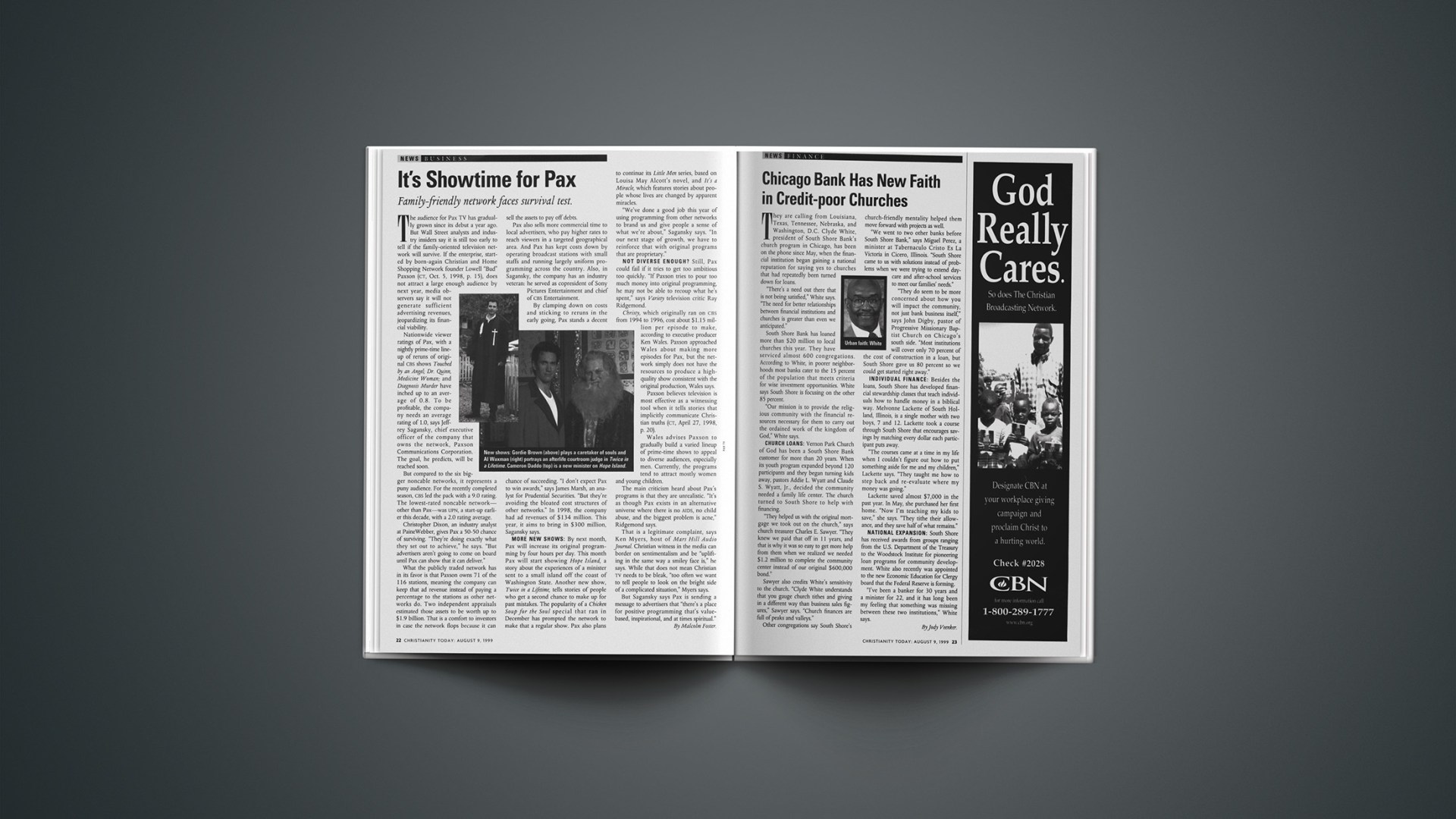The audience for Pax TV has gradually grown since its debut a year ago. But Wall Street analysts and industry insiders say it is still too early to tell if the family-oriented television network will survive. If the enterprise, started by born-again Christian and Home Shopping Network founder Lowell “Bud” Paxson (CT, Oct. 5, 1998, p. 15), does not attract a large enough audience by next year, media observers say it will not generate sufficient advertising revenues, jeopardizing its financial viability.
Nationwide viewer ratings of Pax, with a nightly prime-time line up of reruns of original CBS shows Touched by an Angel; Dr. Quinn, Medicine Woman; and Diagnosis Murder have inched up to an average of 0.8. To be profitable, the company needs an average rating of 1.0, says Jeffrey Sagansky, chief executive officer of the company that owns the network, Paxson Communications Corporation. The goal, he predicts, will be reached soon.
But compared to the six bigger noncable networks, it represents a puny audience. For the recently completed season, CBS led the pack with a 9.0 rating. The lowest-rated noncable network—other than Pax—was UPN, a start-up earlier this decade, with a 2.0 rating average.
Christopher Dixon, an industry analyst at PaineWebber, gives Pax a 50-50 chance of surviving. “They’re doing exactly what they set out to achieve,” he says. “But advertisers aren’t going to come on board until Pax can show that it can deliver.”
What the publicly traded network has in its favor is that Paxson owns 71 of the 116 stations, meaning the company can keep that ad revenue instead of paying a percentage to the stations as other networks do. Two independent appraisals estimated those assets to be worth up to $1.9 billion. That is a comfort to investors in case the network flops because it can sell the assets to pay off debts.
Pax also sells more commercial time to local advertisers, who pay higher rates to reach viewers in a targeted geographical area. And Pax has kept costs down by operating broadcast stations with small staffs and running largely uniform programming across the country. Also, in Sagansky, the company has an industry veteran: he served as copresident of Sony Pictures Entertainment and chief of CBS Entertainment.
By clamping down on costs and sticking to reruns in the early going, Pax stands a decent chance of succeeding. “I don’t expect Pax to win awards,” says James Marsh, an analyst for Prudential Securities. “But they’re avoiding the bloated cost structures of other networks.” In 1998, the company had ad revenues of $134 million. This year, it aims to bring in $300 million, Sagansky says.
MORE NEW SHOWS: By next month, Pax will increase its original programming by four hours per day. This month Pax will start showing Hope Island, a story about the experiences of a minister sent to a small island off the coast of Washington State. Another new show, Twice in a Lifetime, tells stories of people who get a second chance to make up for past mistakes. The popularity of a Chicken Soup for the Soul special that ran in December has prompted the network to make that a regular show. Pax also plans to continue its Little Men series, based on Louisa May Alcott’s novel, and It’s a Miracle, which features stories about people whose lives are changed by apparent miracles.
“We’ve done a good job this year of using programming from other networks to brand us and give people a sense of what we’re about,” Sagansky says. “In our next stage of growth, we have to reinforce that with original programs that are proprietary.”
NOT DIVERSE ENOUGH? Still, Pax could fail if it tries to get too ambitious too quickly. “If Paxson tries to pour too much money into original programming, he may not be able to recoup what he’s spent,” says Variety television critic Ray Ridgemond.
Christy, which originally ran on CBS from 1994 to 1996, cost about $1.15 million per episode to make, according to executive producer Ken Wales. Paxson approached Wales about making more episodes for Pax, but the network simply does not have the resources to produce a high-quality show consistent with the original production, Wales says.
Paxson believes television is most effective as a witnessing tool when it tells stories that implicitly communicate Christian truths (CT, April 27, 1998, p. 20).
Wales advises Paxson to gradually build a varied lineup of prime-time shows to appeal to diverse audiences, especially men. Currently, the programs tend to attract mostly women and young children.
The main criticism heard about Pax’s programs is that they are unrealistic. “It’s as though Pax exists in an alternative universe where there is no aids, no child abuse, and the biggest problem is acne,” Ridgemond says.
That is a legitimate complaint, says Ken Myers, host of Mars Hill Audio Journal. Christian witness in the media can border on sentimentalism and be “uplifting in the same way a smiley face is,” he says. While that does not mean Christian TV needs to be bleak, “too often we want to tell people to look on the bright side of a complicated situation,” Myers says.
But Sagansky says Pax is sending a message to advertisers that “there’s a place for positive programming that’s value-based, inspirational, and at times spiritual.”
Copyright © 1999 Christianity Today. Click for reprint information.










